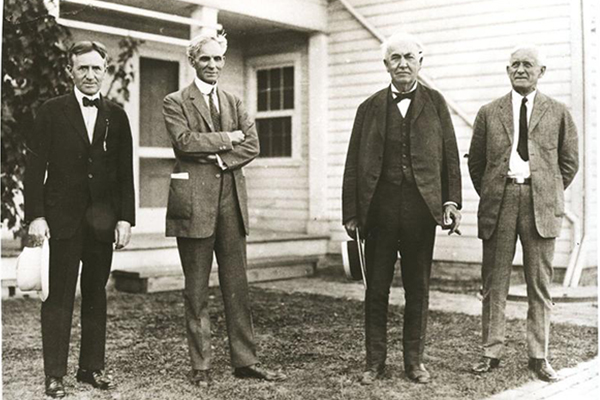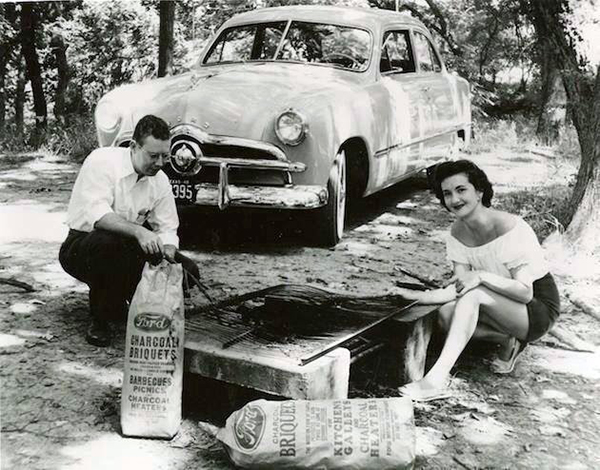Henry Ford
Henry Ford And The Invention Of Kingsford Charcoal
Useless Media | March 2, 2019 | Amazing Facts, Automotive, Featured, Foodies, History, Science
WHO MADE THAT CHARCOAL BRIQUETTE?
What do Henry Ford and barbecues have in common? It turns out quite a lot and it’s a tale you might want to share with your buds at your next backyard get-together.
HENRY FORD LOVED CAMPING
The story begins in the summer of 1919 when carmaker Henry Ford, tire magnate Harvey Firestone, and naturalist John Burroughs went on one of their annual camping trips. These super-rich pals traveled in style, bringing along their chauffeurs and a chef in a convoy of six vehicles. Today, this would be called “glamping” (as in glamorous camping).
Harvey Firestone, Henry Ford, Thomas Edison, And Edward Kingsford posing for photo circa 1930
On this particular outing, Ford invited along a real estate agent named Edward G. Kingsford, so they could discuss ways to find and buy timberland. Kingsford was married to Ford’s cousin, Minnie, whom he was very close with. Ford badly needed wood for his Model T’s since between their frame, running board, dashboard, and wheel spokes, each car used about 100 board feet of hardwood. Considering that Ford produced about a million cars a year, that’s a heck of lot of wood. Kingsford came through and acquired 313,000 acres of timberland in Iron Mountain, Michigan – just what Ford needed.
HENRY FORD WAS AN ENVIRONMENTALIST AND HATED WASTE
Ford built a sawmill to cut the wood for shipping to Detroit but there was a problem. The mill generated lots of waste in the form of stumps, branches, and sawdust. This irked Henry for two reasons: He didn’t like to leave money lying on the ground and he was an early environmentalist who lived by the motto: “reduce, reuse, and recycle.”
HENRY FORD CREATED FORD CHARCOAL BRIQUETTES
So, what does this all have to do with backyard barbecues? Well, as an avid camper, Henry knew that it was difficult to find enough dry kindling to build and sustain a campfire. So, with the help of a chemist, he took the excess scraps from his sawmill and pressed them into lumps held together by tar and cornstarch. Sure enough, they proved a quick and easy way to keep a fire hot. After calling them “charcoal briquettes”, he opened the Ford Charcoal factory and it was built next to his sawmill. As a thank you for his help, he let Kingsford run it.
Henry Ford Charcoal Advertisement
FORD CHARCOAL CHANGED IT’S NAME TO KINGSFORD IN 1951
A model of efficiency, Ford’s factory produced 610 pounds of briquettes for every ton of scrap wood. Soon, Ford was marketing “Picnic Kits” containing charcoal and portable grills to promote motoring and outdoor adventures. After Henry Ford died in 1947, a group of investors bought Ford Charcoal in 1951 and renamed it Kingsford Chemical Company in order to pay tribute to the companies heritage. Today, Kingsford Charcoal is more popular than ever. In fact, every year more than one million tons of wood waste finds new life as charcoal briquettes.
Something to think about the next time you’re grillin’ your grub.




Comments
I worked at the Kingsford plant in Belle Mo. for awhile they're very proud of that heritage
Very interesting select-fire. Thanks for sharing.
SF, very, very interesting. Thanks for sharing.-------------------------Ray
I just learned something.
The next thing you know, the greenie weenies will push to outlaw charcoal -
If that happens, war will be declared. Nobody messes with my grilling! Bob
Fascinating story.
Henry Ford was an interesting fellow! My grandmother met him once quite by accident on the streets of Traverse City Michigan. As she was hurriedly rounding a corner she ran smack dab into him! She told me that he was quite the gentleman and even helped her pick up the package she was carrying.
@select-fire This is a story I already knew, but it is nice to share for those who didn't, I buy Kingsford charcoal the week before every major holiday as they always have it on sale at the big box stores, it has changed sizes, shapes and of course the price over the years, but if buying in somewhat bulk at the right times of the year it has served me well. I go through about 4 20lbs bags a month this time of year, smoking and grilling about 80% of our main meals of the day. Of course I also use mesquite chunks being here in Texas. Thanks for the reminder of this heritage.
👍️ a story i have heard before.......very cool.
Another story about Henry and his "waste not, want not" demeanor. Back then they shipped auto parts in wooden boxes. Henry sent the vendors templates to cut the wood to the correct sizes for his cars. When the boxes were broken down they were used for floor panels, framing, and other wooden parts in the construction of his vehicles.
Joe
The old slogan "Ford has a Better Idea" had a reason behind it... 😊
"Never do wrong to make a friend----or to keep one".....Robert E. Lee
I think I read that Ford made concrete mix from left over ingredients from his glass manufacturing operation.
I've read this story before. I too am a Kingsford Charcoal fan and find everything tastes better cooked over Kingsford Charcoal.
old Henry was a bright fellow he came up with and did so much he was truly a amazing fellow I heard he would walk the line any one doing a great job was likely to be handed money by him for the extra effort and any one slacking was most likely escorted out
he also had ford stamped every nut and bolt and part on all the jeeps they made during the war he wanted to make sure any repairs on brought back vehicles were made by Ford and not one of the other company's. no way he wanted to spend his money fixing some one else product .
he was one of the hand full of million airs that ran the country (basically ) during his time in power